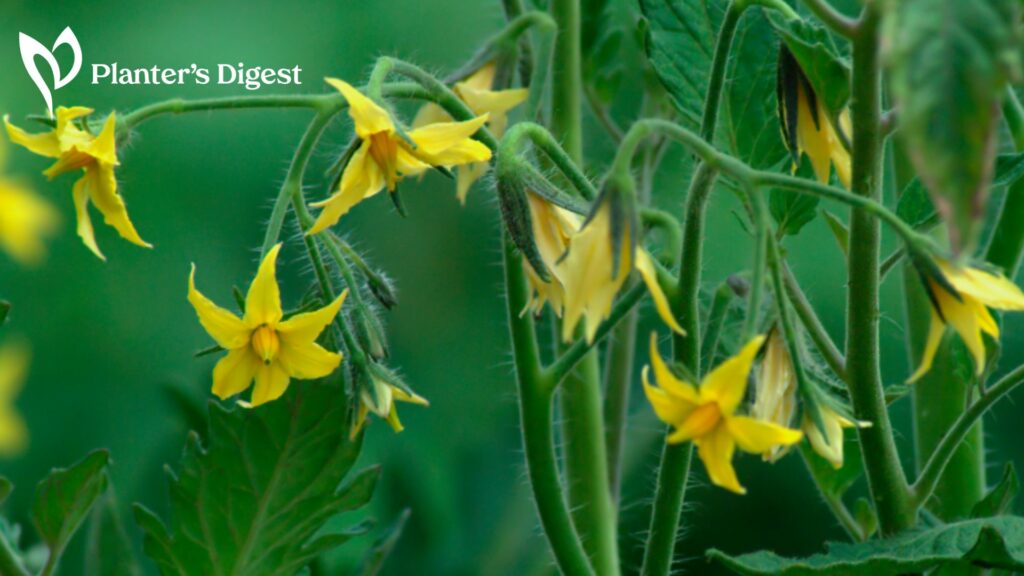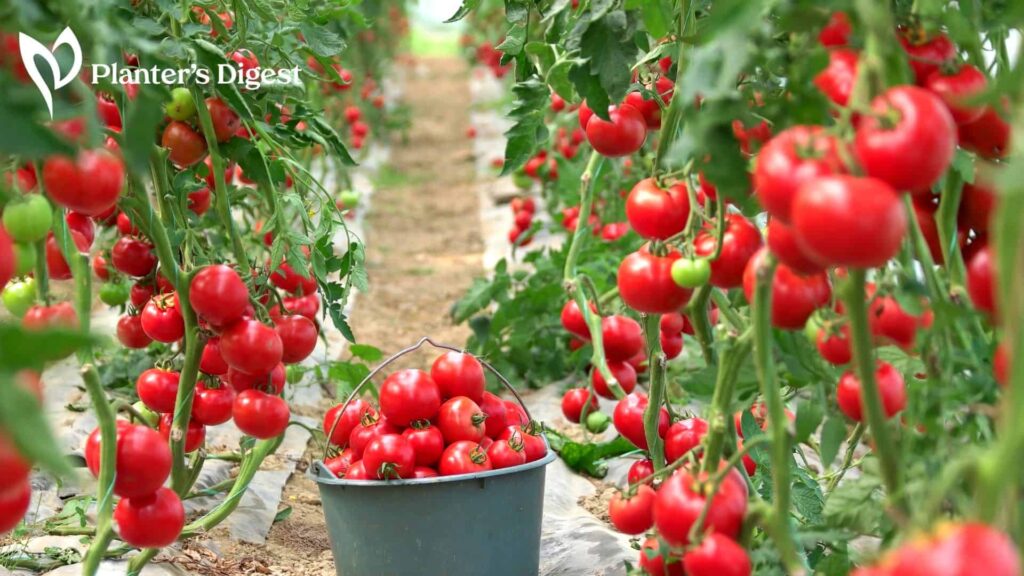
Don’t you just hate the feeling of someone breathing down your neck? Tomato plants can relate to the stress this brings, too!
The question is, how do you know if they’re planted too close together?
We’ve got the key to properly spacing your tomato plants for maximum yields depending on your plant and garden type, so read on!
Importance of Spacing Tomato Plants
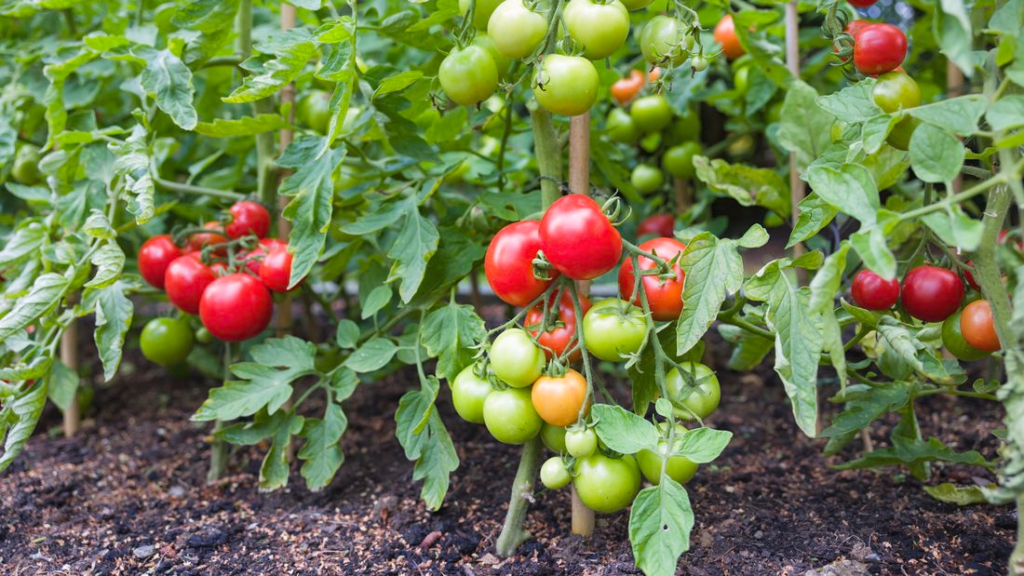
Adequately spacing your tomato plants is essential if you want to win the best harvest of the season.
Even if that isn’t a thing, giving your tomato plants enough room to grow is beneficial for many reasons, from increased productivity to disease prevention. All of which can affect the overall health and well-being of your plant.
So if you’re curious to know how, allow us to break them down one by one.
1. Improved Air Circulation

Improved air circulation increases productivity in a variety of ways. For one, gardens with good airflow help improve the exchange of gasses in the area.
To be specific, adequate ventilation helps bring more CO2 to the plant leaves, which is essential during photosynthesis. Thus, the more access your plant has to CO2, the more productive it’ll be.
Apart from that, good airflow also helps regulate temperatures, especially in warmer climates. Getting fresh wind in the area aids in preventing the development of hot spots.
It’s kind of similar to how a room with closed windows gets stuffy during the summertime. Don’t you just love the relief of a cold, gentle breeze coming in on a hot summer’s day?
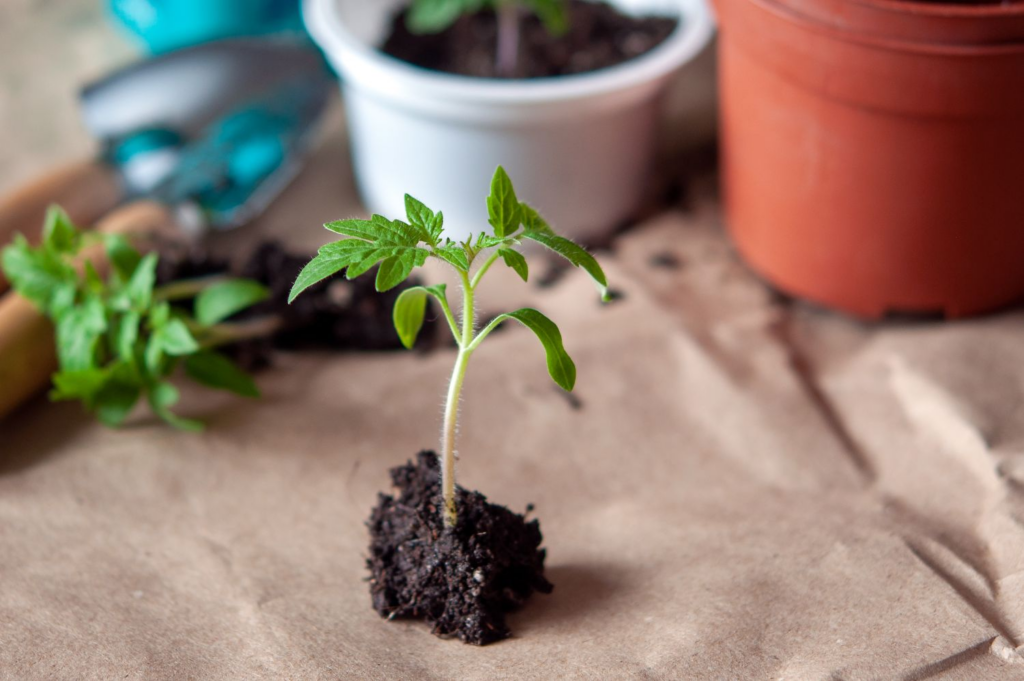
Apart from that, the natural movement from the wind helps your young tomato plant become stronger by releasing more of its natural growth hormone.
This is especially crucial for a tomato plant seedling as it helps make its stem tougher and thicker as it develops. Overall, you’ll notice a happier plant.
As you can see, adequately spacing your tomato plants, even at a young age, already brings a ton of benefits.
2. Increased Production

Gardeners would do anything to boost production which is why we’ve got all of these crop enhancers and fertilizers (row 273), but providing proper spacing is just as important as these supplements.
The biggest advantage of giving your tomato plants enough room is that they can develop a deep and extensive root system. With this, they’ll be able to get as much water (row 267) and nutrients from the soil as possible with little fuss.

It’s important to remember that tomato plants grow roots as deep as 3 feet into the soil.
If you grow plants too close together, chances are their roots will get entangled with one another because there isn’t enough space.
By the same token, they’ll also be competing for limited resources, which will definitely cause unnecessary stress. You could notice poor health in the form of stunted growth or reduced fruit production.

It’s also no secret that tomato plants are heavy feeders, which means they need a ton of nutrients and minerals to be able to grow and produce healthy yields.
So if you’re in the running to having the #1 healthiest, juiciest, and plumpest, tomatoes, then you’ll want to give each plant the right amount of space.
3. More Sunlight
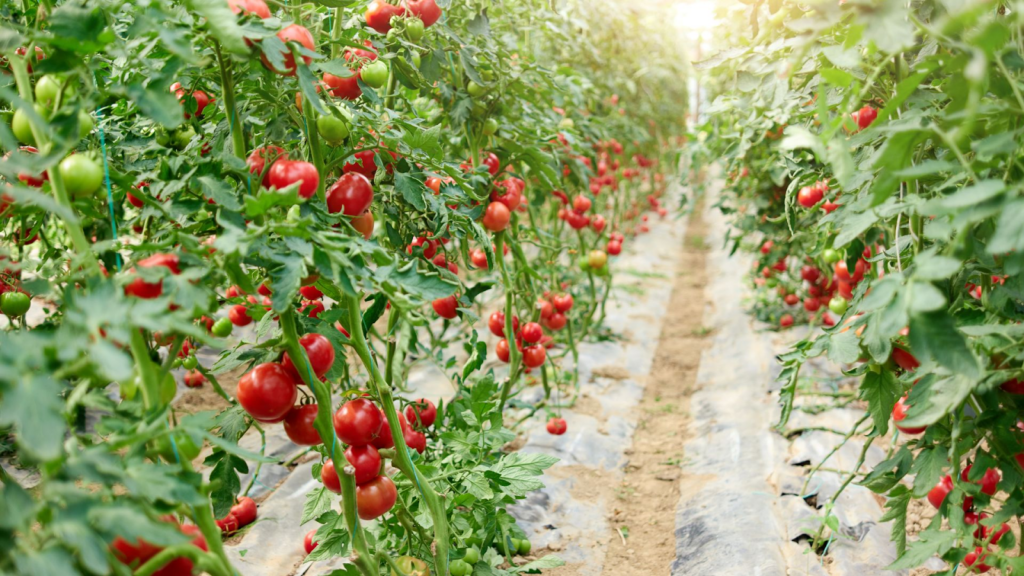
Ensuring that your tomato plants are adequately spaced allows them to receive equal amounts of sunlight. If they’re too close to one another, there’ll be too much foliage going around, causing shade.
While they don’t look like they do, tomato plants absolutely love the heat. In fact, they typically need anywhere from 6 to 8 hours of direct sunlight daily.
While this may seem like a lot, some tomato plant varieties need even more than that. They need enough sunlight to be able to grow strong stems along with a ton of foliage, flowers, and fruit.
4. Disease Prevention

Adequate airflow is one of the most important yet overlooked aspects of gardening that influences the overall health of your plants.
The lack of proper ventilation and air circulation, especially in indoor gardens, increases the likelihood of bacteria, germs, and fungi spreading within the area.
Keep in mind that reduced airflow raises humidity levels. This is the kind of environment harmful microorganisms are looking for to grow quickly and multiply.
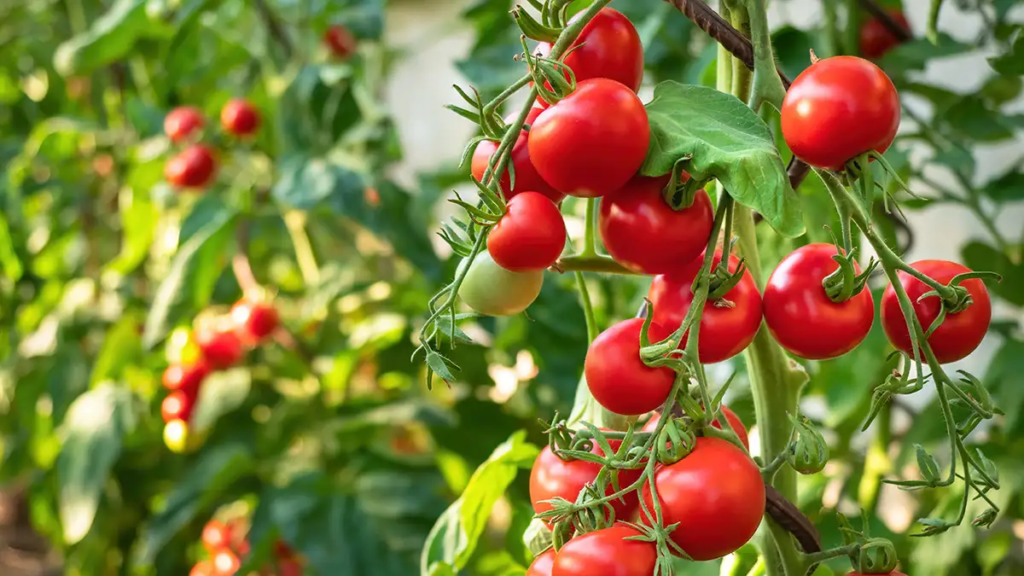
Think about it this way: the closer you are to someone who has a cold, your chances of catching that cold are higher.
It’s the same thing with plants – if a plant that has a fungal infection is near your tomato plant, chances are it might get infected, too, especially if it’s not in tip-top shape, to begin with.
As a result, appropriately spacing your tomato plants provides enough room for the air to move freely, helping regulate temperatures and humidity.
4. Room for Companion Plants
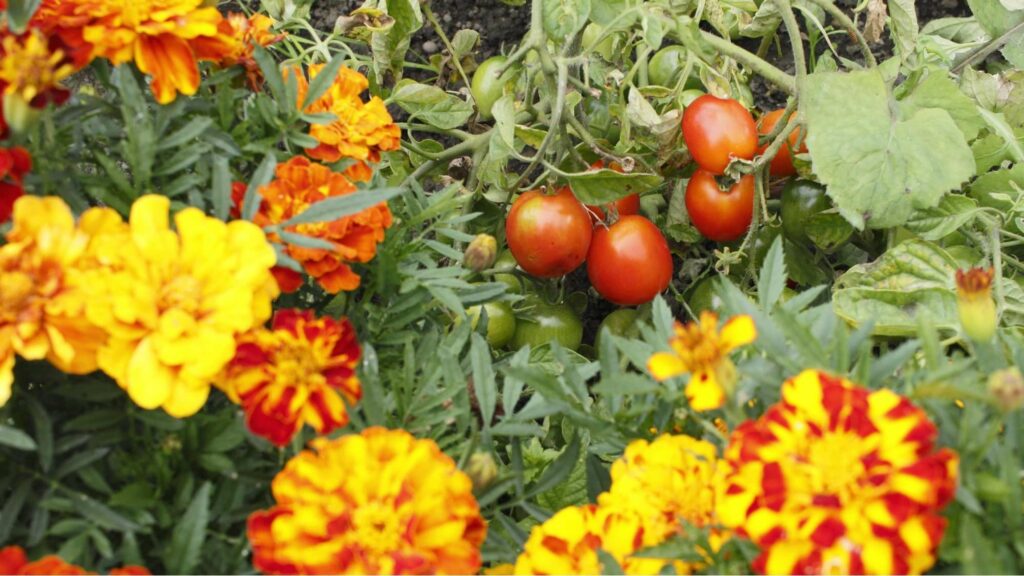
Spacing your tomato plant gives you enough room for adding other plant buddies. This practice is called companion planting.
If you’ve never heard of companion planting before, it’s essentially bringing in other plants that add a ton of benefits when grown alongside your tomato plant.
By bringing in valuable players, er, plants, you’re providing your tomato plant additional support as it grows. Complementary plants can aid in the following:
- Repelling pests
- Improving soil quality
- Increasing pollination
- Enhancing flavor
Apart from that, adding companion plants also makes your garden look a lot better by bringing in diversity and pops of color if we do say so ourselves.
For your convenience, we’ve listed a few companion plants that you can grow alongside your tomato plant along with their added benefits:
| Companion Plant | Type | Benefits |
| Basil | Herb | • Naturally repels pests such as hornworms, whiteflies, and aphids • Enhances the flavor of tomatoes |
| Borage | Herb | • Brings in beneficial insects and pollinators • Deters harmful pests like tomato hornworms • Improves the flavor of tomatoes |
| Chives | Herb | • Attracts beneficial insects like hoverflies and ladybugs • Boosts the taste of the tomatoes |
| Carrots | Herb | • Helps break up the soil which improves compaction, erosion, and drainage • Enhances the flavor of tomatoes |
| Marigold | Flower | • Naturally emits a strong scent that repels pests such as nematodes and whiteflies • Attract beneficial insects such as ladybugs and lacewings that prey on harmful bugs |
| Nasturtiums | Flower | • Repels harmful insects like aphids and whiteflies |
| Garlic | Vegetable | • Naturally repels bad insects like spider mites, whiteflies, and aphids • Helps improve the taste of tomatoes |
| Cucumbers | Vegetable | • Retains moisture in the soil • Repels pests like aphids and beetles • Provides shade |
| Spinach | Vegetable | • Prevents soil erosionRetains moisture in the soil • Provides shade • Attracts beneficial insects such as ladybugs and wasps |
| Beans | Legumes | • Fixes the nitrogen levels in the soil • Improves the soil structure • Deter pests like beetles and aphids |
Effects of Poor Spacing

The effects of poor spacing can be more severe than you think. From low productivity to even vulnerability to pests and diseases, the future doesn’t look too pretty for tomatoes that have been planted too close together.
To give you a better idea of what we mean, let us explain.
1. Low Productivity
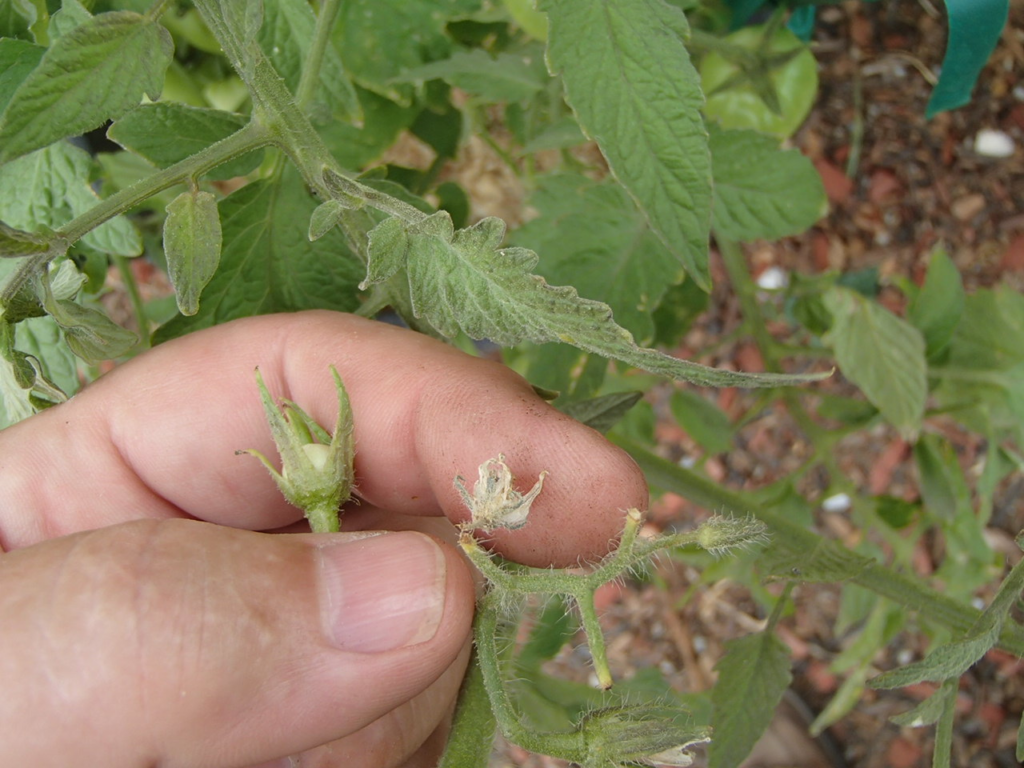
Keep in mind that limited space = limited productivity. This is because having no room to grow can have a detrimental impact on your tomato plant’s development and functionality.
Poorly grown roots mean that your tomato plant could have difficulties in nutrient and water uptake. If so, your tomato plant won’t be looking as tall or tough as the others.
Planting tomatoes too close together also increases the competition for resources. We don’t just mean minerals and nutrients, but also water, sunlight, and fertilizer.
If your tomato plant’s too stressed out about limited resources, it won’t prioritize growing flowers and producing fruits. In fact, that’ll be at the bottom of its agenda because it’s too focused on surviving.
2. Vulnerability to Pests and Diseases

Regardless of shape and size, we all know how difficult it can be to handle pests (tomato pests – row 261) and diseases once they’ve entered our garden.
Hence, it’s important to leave an ample amount of space between each plant because a crowded space increases the vulnerability to attacks.
Aphids, slugs, and whatever insect you can think of can easily crawl from one tomato plant to the next when they’re all crowded together.
The same can be said about diseases as it takes just a bit of wind for the spores of a fungal infection to transfer from one plant to the next.
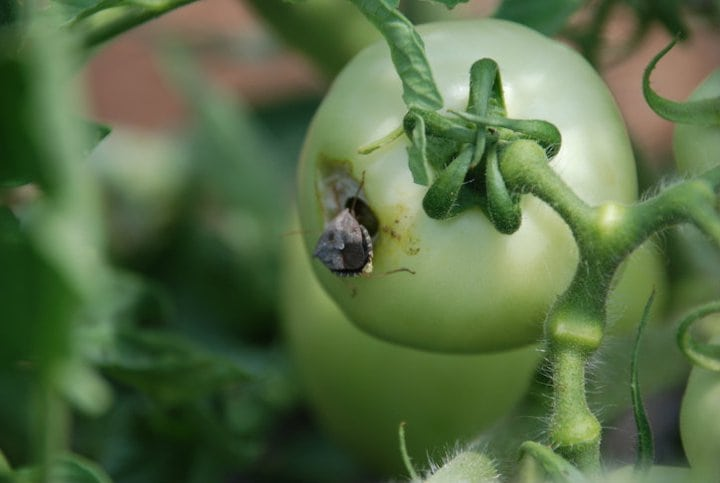
So if you don’t want your enemies, er, pests to have a feast day in your garden, you may want to space out your plants.
That’ll give you enough time to manage plants that have already been infected, hopefully increasing the chances of saving the rest of your garden.
3. Stunted Growth

Keep in mind that limited space = limited root development. Because your tomato plant’s too close to other plants, there isn’t enough room for it to grow an extensive root system.
This could cause the plant to be delicate and frail. In worse cases, it could reduce your plant’s growth. As a result, your plant will have difficulties handling windy weather or heavy fruit sets.
Apart from that, growing incredibly close to other plants means that there are fewer nutrients, minerals, and water in the soil as the competition is just too tough.
Without sufficient resources, your tomato plant’s growth can slow down.
4. Limited Air Circulation
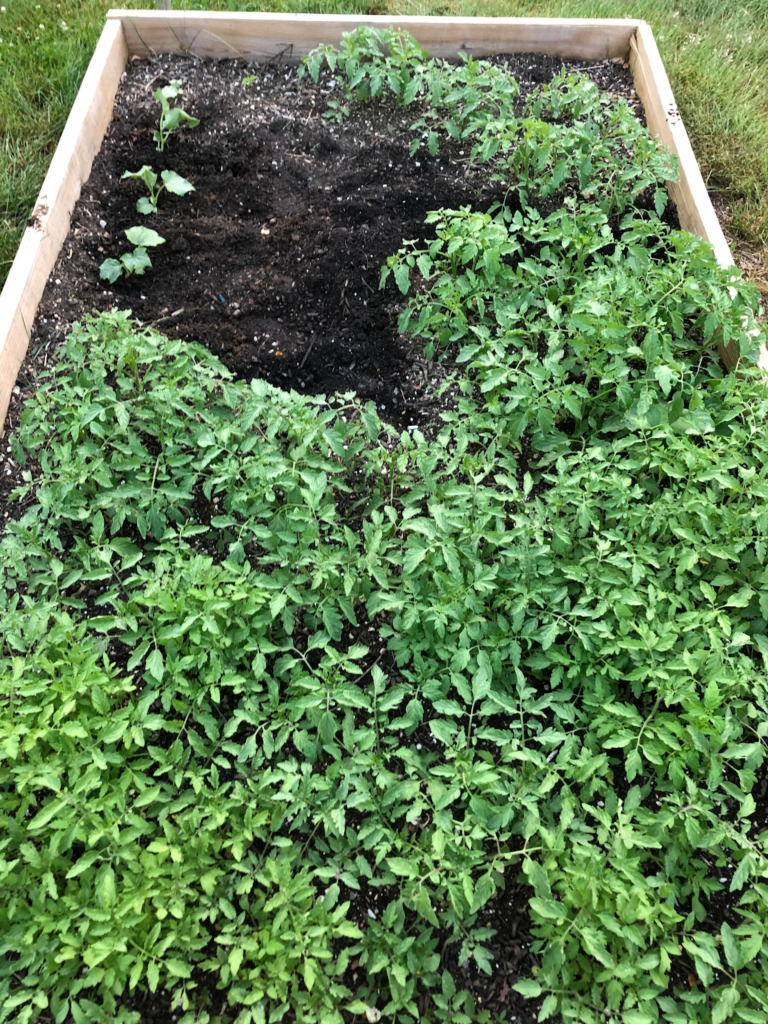
When plants are growing in a small space, there’s no more room for air to circulate. This could cause an increase in the humidity levels of the area, making them more susceptible to developing fungal diseases.
Limited air circulation could also raise the moisture levels in the area as there’s no wind to dry off wet foliage.
Fungi thrive in warm, moist, and humid environments. If you’ve got all three, you’ve made the perfect environmental conditions to germinate and grow fungal spores.
If you’ve got a ton of other plants in the area, this is any gardener’s worst nightmare because all it takes is a gentle breeze to spread the spores to other parts of your garden.
How To Adequately Space by Tomato Plant Type
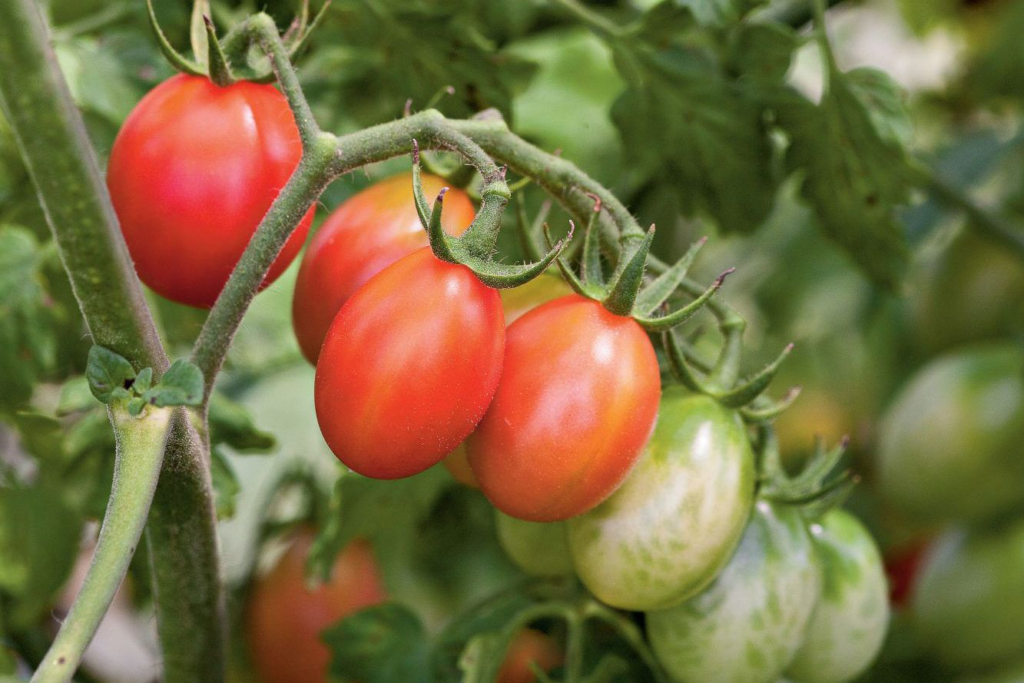
When it comes to adequately spacing your tomato plants, you’ll need to take into consideration how much space it actually needs depending on their plant type.
There are two kinds of tomato plants – determinate tomato varieties and indeterminate tomato varieties. What sets these two types apart is their growth habit.
Read on as we break down the difference between the two.
Determinate Tomato Varieties

Determinate tomato varieties are also called “bush” tomatoes because of their growth habit. They grow in short, compact clusters that only reach about 3 to 4 feet tall.
Because of their sprawling nature, they technically don’t need any structural support such as trellises or tomato cages. They can hold themselves upright pretty well and tend to outgrow these quickly.

However, because of how bushy they can get, determinate tomato plants need to be spaced at least 18 to 24 inches apart.
Otherwise, it’s fairly easy for their foliage to block air circulation. The high humidity levels will cause an increase in the spread of diseases and infections.
What’s great about determinate tomato varieties is that they tend to produce several fruit clusters at the top, which all ripen at the same time.
Hence, they’re a popular choice for gardeners and farmers who prefer a large harvest in a single go.
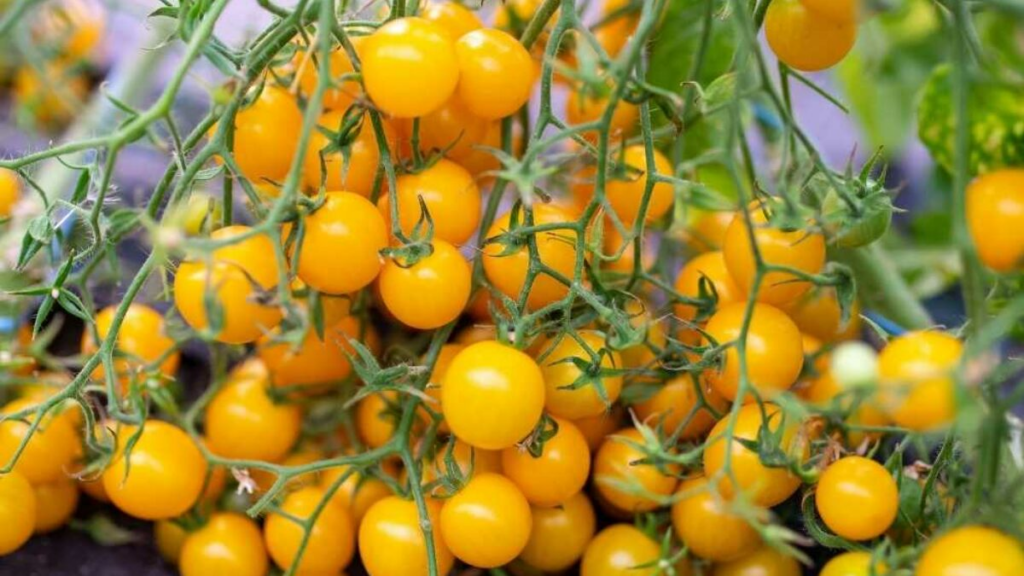
Because of this, spacing is important to ensure that each tomato plant has enough water, nutrients, and sunlight in its spot.
Tomato plants that are grown too close together can get stressed out by having to compete for resources.
For a healthy harvest, a general rule of thumb is to grow your tomato plants at least 2 to 3 feet apart. When it comes to rows, space them about 3 to 4 feet apart.
Here’s a list of some well-known determinate tomato varieties include:
- Rutgers
- Monica Roma
- Celebrity
- Glacier
- Bush Early
- Plum Regal
- Washington Cherry
- Gold Nugget
Indeterminate Tomato Varieties
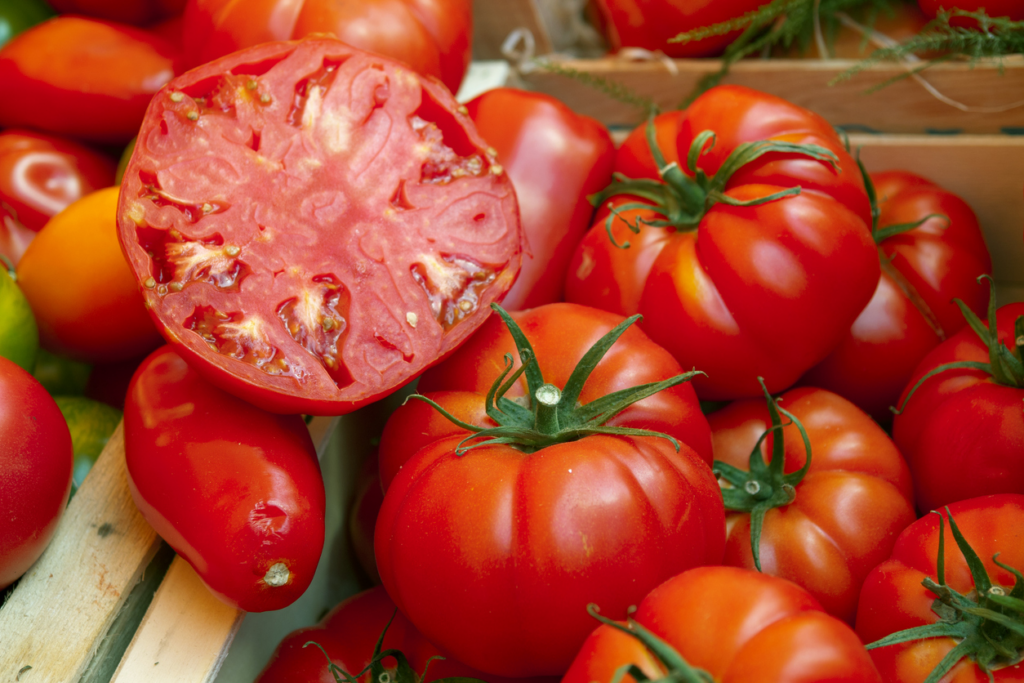
Indeterminate tomato varieties, on the other hand, are known as “vining” tomatoes. This is because they have a crawling growth habit, which gets them as long as 10 feet or more, depending on the type.
Those growing these kinds of tomatoes know how easy it is for them to get tangled and intertwined.
Without proper constant intervention, they’ll just get even more into a mess, which can make it tricky to harvest any fruits.

This can also cut off air circulation and sunlight between plants, bringing about even more problems.
Tangled clumps of foliage will also prevent adequate air circulation. Without this, the buildup of moisture will make your tomato plants susceptible to a variety of bacterial and fungal diseases.

Because they’re so closely planted together, it won’t take long until all nearby plants are infected, too.
Indeterminate tomato varieties will need extra support in the form of tall cages, stakes, or trellises to prevent them from getting tangled in one another.
They’ll also need to be at least 2 to 3 feet apart from one another in rows that are spaced at least 3 to 4 feet apart.
In case you’re wondering, here are a few popular indeterminate tomato varieties:
- Beefsteak
- Goldie
- Big Boy
- Sweet Million
- Brandywine
- Sungold
- Early Girl
- Green Zebra Tomato
- Arkansas Traveler Tomato
How To Adequately Space by Container Type

After you’ve decided which tomato plant variety you’ll be growing, the next consideration is to figure out which container best suits its sizing needs.
Different tomato varieties can grow in various containers, from pots to raised beds. To learn more about how to give your tomato plants the right amount of space in each, read on.
1. Buckets or Pots
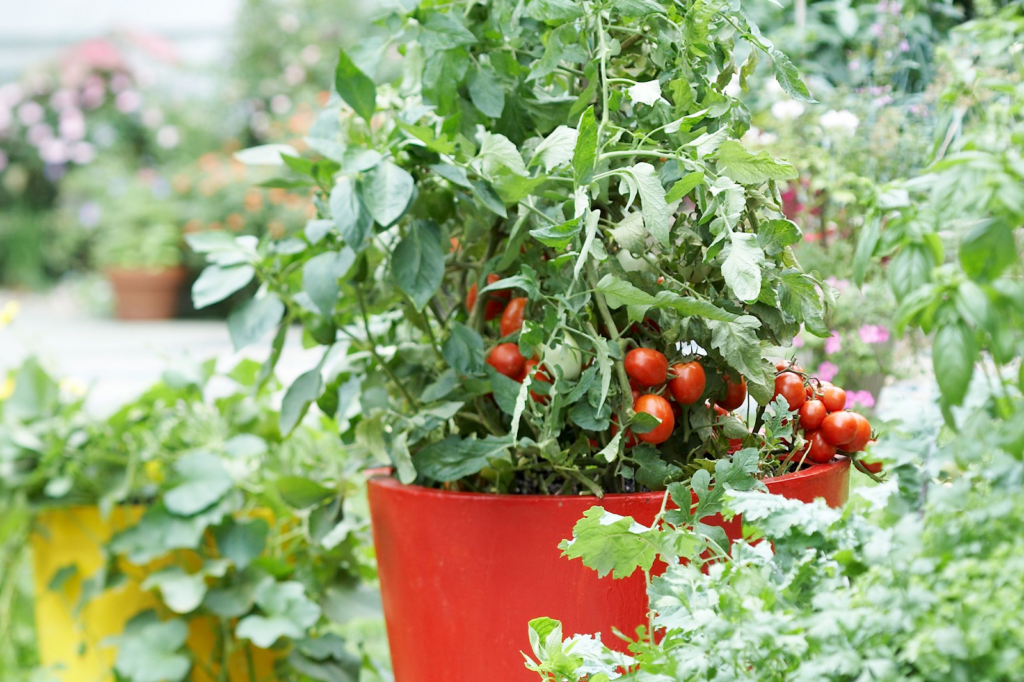
Tomato plants grow a rather extensive root system, which is why they need relatively deep pots to be able to support their root development.
Other than that, a deep pot allows them to get as much nutrients, minerals, and water from the soil as possible.
It’s a general rule of thumb to always get a pot that’s bigger than what you think your tomato plant needs. Most tomato plant varieties need a pot that’s at least 16 to 18 inches in diameter and 12 to 14 inches deep.
This is because a pot that’s too small to accommodate your plant will cause it to become root-bound. As a result, this can stunt your tomato plant’s growth and limit its fruit production.
To give you a better idea of how much space your tomato plant will need, check out our reference table:
| Container Size | Spacing for Determinate Tomato Varieties | Spacing for Indeterminate Tomato Varieties |
| Small (12 to 14-inch diameter) | Grow just 1 plant per container | Grow just 1 plant per container |
| Medium (16 to 18-inch diameter) | At least 12 to 18 inches from the sides | At least 18 to 24 inches from the sides |
| Large (20-inch or more diameter) | At least 18 to 24 inches from the sides | At least 24 to 36 inches from the sides |
2. Ground
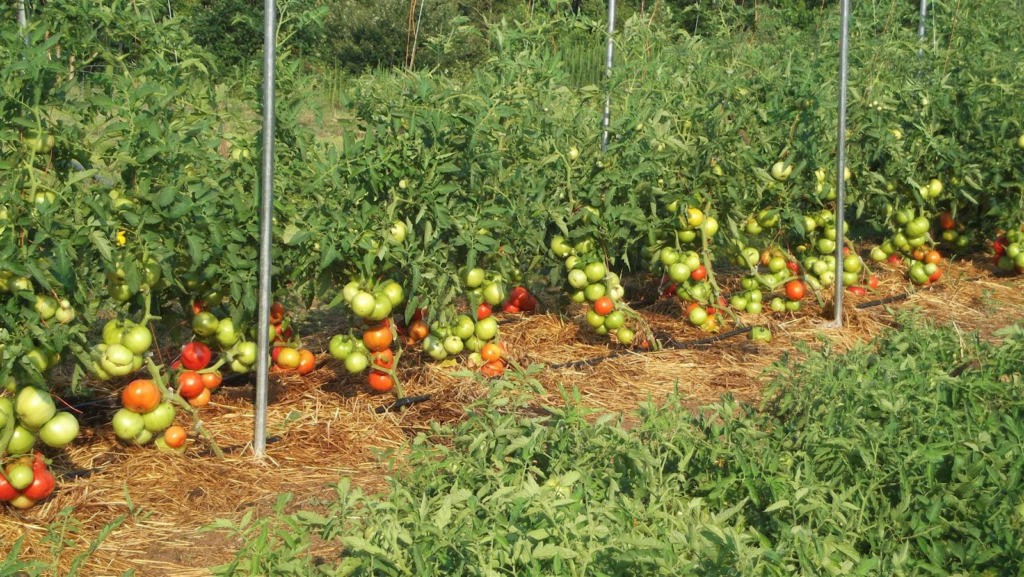
Growing your tomato plants in the ground gives them enough space to grow a deep and extensive root system. Resource uptake will be easier as their roots can grow further down into the soil.
Hence, growing in-ground determinate and indeterminate varieties is doable. Though be sure to provide additional support, if necessary, to prevent them from becoming too heavy and falling over.
Because determinate tomatoes are usually smaller, you can get away with growing them in smaller spaces.

Nevertheless, you still want to ensure that your tomato plants aren’t growing too close to each other.
For determinate tomato varieties, give them at least 18 to 24 inches of space between each plant. This way, they have enough room to develop a sizable bush.
Indeterminate tomato varieties, on the other hand, need a bit more space. They should have at least 24 to 36 inches between them to prevent any tangles.
| Spacing for Determinate Tomato Varieties | Spacing for Indeterminate Tomato Varieties |
| At least 18 to 24 inches apart | At least 24 to 36 inches apart |
3. Raised Bed

Raised beds are great for both determinate and indeterminate varieties because they’re relatively deep. This is because raised beds have a ton of beneficial layers, from high-quality topsoil to compost.
The total number of tomato plants that your raised bed can accommodate will depend on its size.
A raised bed that’s 4 feet wide and 8 to 10 feet long can house about 6 to 8 tomato plants. However, this still depends on the tomato variety.
While we do understand your longing to grow as many tomatoes as possible, we highly recommend only planting what your raised bed can accommodate.
| Spacing for Determinate Tomato Varieties | Spacing for Indeterminate Tomato Varieties |
| Spaced at least 18 to 24 inches apart with rows spaced 24 to 36 inches apart | Spaced at least 24 to 36 inches apart with rows spaced 48 to 60 inches apart |
FAQs on Tomato Plant Spacing
Remove the lower leaves to help promote air circulation by the base of the stem where moisture tends to collect. You can also prune the rest of the foliage to help manage the humidity levels to prevent fungal growth.
Within 1 hectare of land, you can grow about 250 to 500 tomato seeds.
Depending on the type of tomato, it can grow anywhere from 3 to 12 feet tall. Determinate tomato varieties typically grow to 4 feet, at most. Meanwhile, indeterminate varieties can grow up to 12 feet tall.
After transplanting, it only takes anywhere from 60 to 100 days before your tomato plant will be growing fruits. Though it’s important to consider that climate and variety can affect how long it’ll take before you can harvest.




